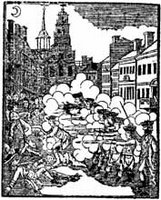Naming a Massacre
 Bostonians started to call the killings on King Street on 5 Mar 1770 a “massacre” almost immediately, according to the official record. The minutes of the emergency town meeting that started the next day begin:
Bostonians started to call the killings on King Street on 5 Mar 1770 a “massacre” almost immediately, according to the official record. The minutes of the emergency town meeting that started the next day begin:
At a Meeting of the Freeholders and other Inhabitants of the Town of Boston at Faneuil Hall on Tuesday the 6th. Day of March 1770 – 11 O’Clock A:M; occasioned by the Massacre made in King Street, by the Soldiery the preceeding Night . . .That clerk was William Cooper, and it appears he was the person who started to apply the term “massacre” as he took notes at that meeting.
Upon a Motion made it was Voted, that if any of the Inhabitants present could give information respecting the Massacre of the last Night, that they be desired to do it in Meeting, that the same might be minuted by the Town Clerk
By the end of that town meeting that afternoon, Cooper was writing the phrase “horrid Massacre.” On the afternoon of the 12th, that had become “the late horred Massacre.” The latter meeting had chosen a small committee headed by James Bowdoin to write Boston’s official report on the event, which had the title A Short Narrative of the Horrid Massacre in Boston.
In choosing that word, Boston Whigs strengthened the links they perceived between them and government reformers in London. The term echoed the Massacre of St. George’s Fields, which had taken place in London in May 1768. A crowd had turned out to show support for the radical politician John Wilkes. Magistrates “read the Riot Act,” ordering the people to disperse. When they didn’t, soldiers fired at the crowd, killing six to eleven people.
A related question is when the term “Boston Massacre” arose. At the end of 1770, Isaiah Thomas published his first Massachusetts almanac, to cover the following year. He had Paul Revere produce a new version of the image he’d taken from Henry Pelham, this time as a woodcut rather than an engraving. Harbottle Dorr pasted that picture in his newspaper collection beside the first reports of the shootings. That example is discolored by glue, but we can see the label “BOSTON MASSACRE” at the top. That phrase also appeared in advertisements for the almanac.
Another label, John Johnson of Minutemen and Their World has pointed out, was “Preston’s Massacre,” after Capt. Thomas Preston, acquitted in late 1770 of having ordered soldiers to fire into the crowd. That phrase appeared in the 5 Mar 1771 issue of Salem’s Essex Gazette, exactly one year after the event. A week later, Edes and Gill reprinted that text in their Boston Gazette, filled out with large display type, dark borders, and a description of Boston’s first-anniversary memorial events.
The war that followed a few years later brought several more events labeled as “massacres”: the Paoli Massacre, Baylor Massacre, Waxhaw Massacre, Cherry Valley Massacre, Sugarloaf Massacre, Pyle’s Massacre, and Gnaddenhutten Massacre. Most of those events were actually fights between the two armies in which one side was really successful at wiping out the other. Only a couple involved attacks on unarmed civilians, with the Gnaddenhutten attack the worst atrocity.

4 comments:
I had heard that, in connection to Boston's Massacre also, someone had been dispatched to find a Magistrate so the same Riot Act could be, by law, read as well. The fighting broke out while the search for the Magistrate was still going on. I forget which historian/author claimed that but is he/she getting it mixed up with the Massacre at St. George's Fields?
One witness testified to hearing others say, "Here's comes Murray to read the Riot Act." That referred to James Murray, a justice of the peace who sided with the royal government. However, no one on either side of the conflict claimed that a magistrate actually did read the Riot Act (or, more accurately, the order to disperse). And there's no evidence in James Murray's letters or other people's remarks that he was actually there.
Murray helped the Crown by collecting testimony of Bostonians' bad behavior in depositions sent to London, some of them published and others in the National Archives. He was also, on behalf of his sister, renting an unused distillery to the army, hence the name of Murray's barracks. So he did play a role in the event, but not necessarily that evening.
Thank you, J.L. Once again another great story watered down by reality and truth.
Here’s a link to the testimony I described.
Post a Comment